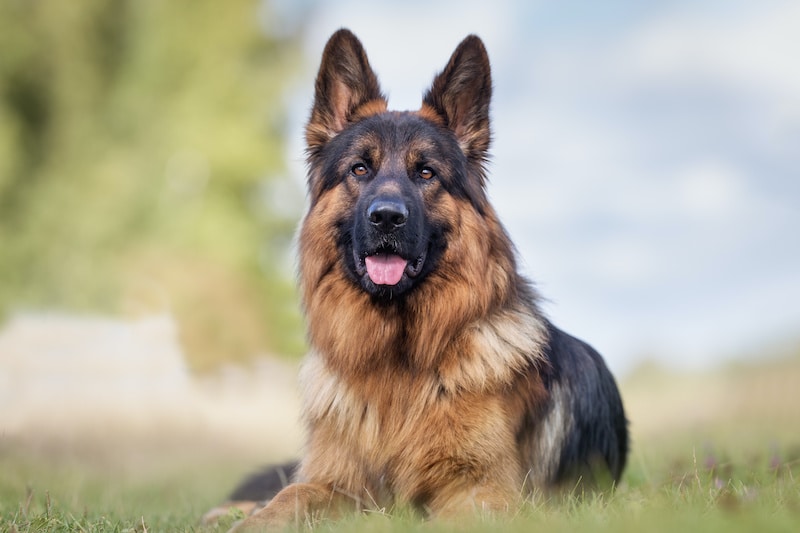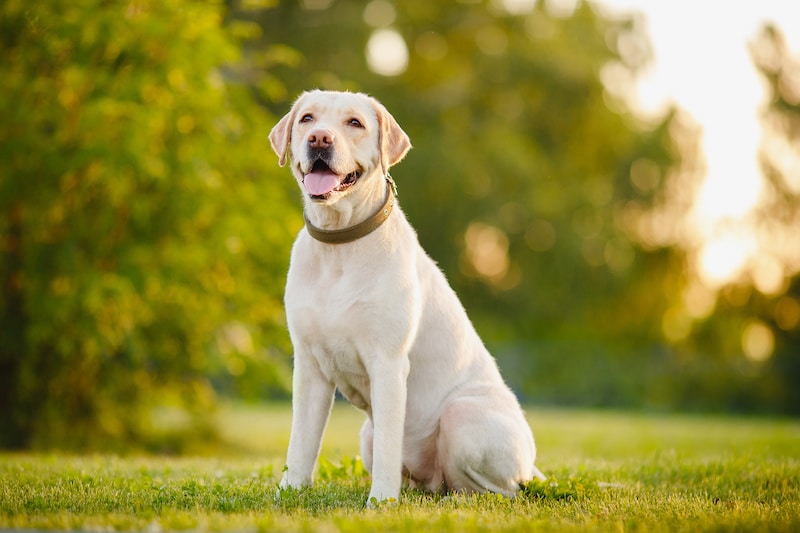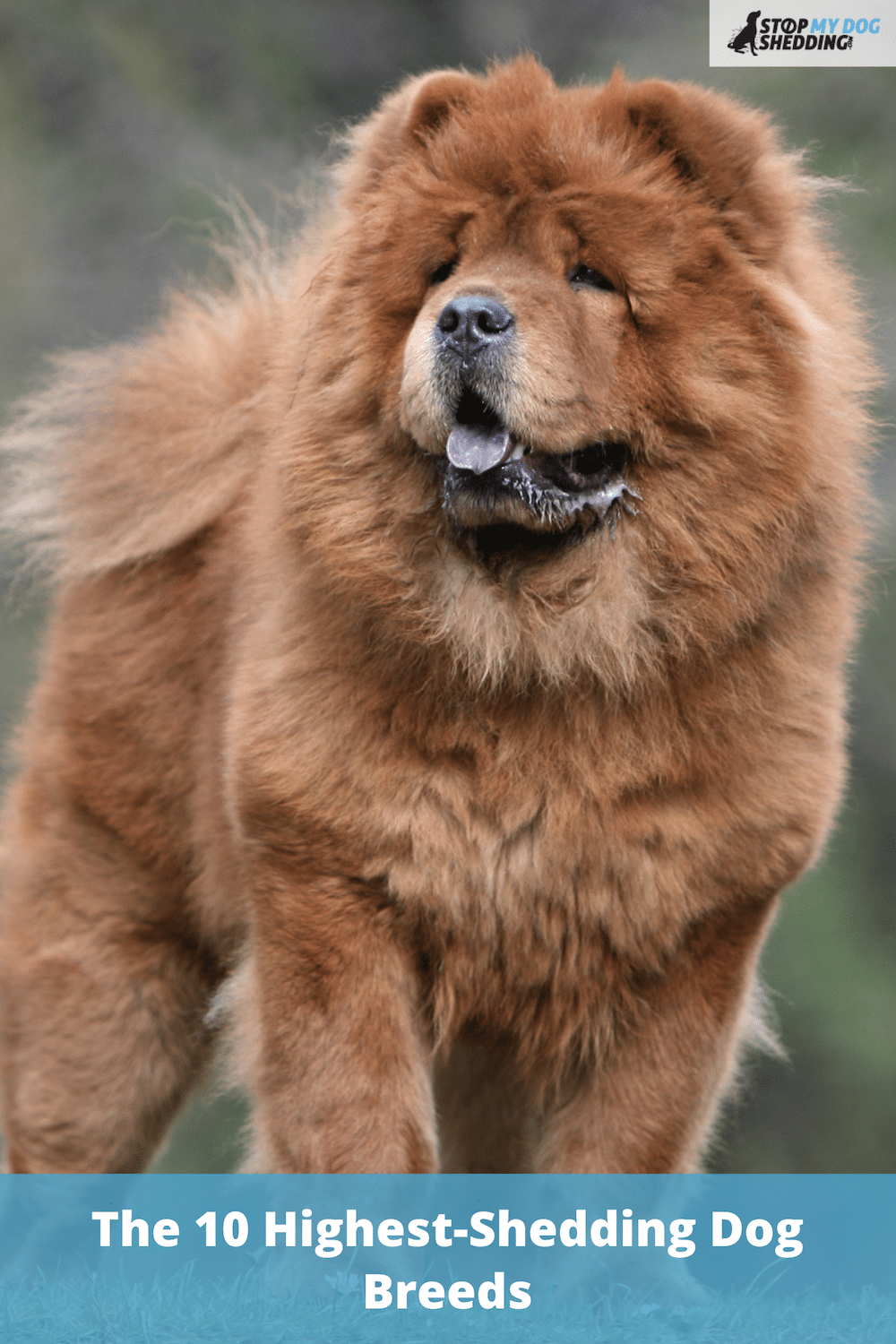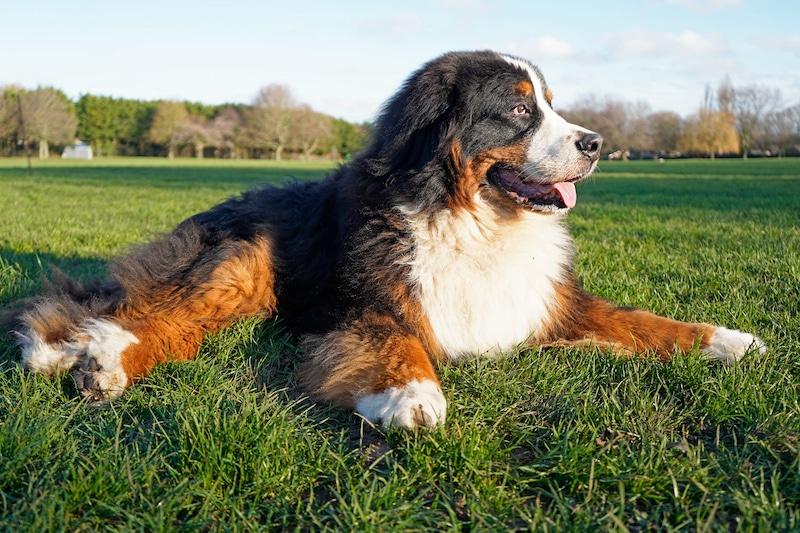I’ve written many posts about low shedding breeds on this site.
But today, I want to look at the other side of the coin because it can be good to know which dogs shed a lot in case you plan to bring one of these fluffy breeds home.
So which dogs are the highest-shedding?
Here’s the list:
- Akita
- Saint Bernard
- Shiba Inu
- Bernese Mountain Dog
- Great Pyrenees
- Chow Chow
- Siberian Husky
- Pembroke Welsh Corgi
- German Shepherd
- Labrador Retriever
Ahead, I’ll show you what makes these 10 dog breeds shed so much. I’ll also discuss the breed’s grooming requirements and present some tips on how to control shedding if you own one of these breeds or plan to in the future. So with that said, let’s get started!
Recommended: Go here to see our top-rated dog hair blow dryers
1. Akita

Starting my list is the Akita, an adorable dog that originated in northern Japan’s mountainous regions. The authentically Japanese Akita is known as the Akita Inu, while the United States-based Akita is appropriately called the American Akita.
It doesn’t matter so much which variety you prefer, as the Akita is a heavy shedder. The breed is double-coated with dense, thick fur. This does not do your clothing or furniture any favors if you hope to keep it hairless.
Fortunately, grooming an Akita is a low-maintenance job. Since regular brushing is one of the best ways to control excessive shedding, I recommend you comb your Akita several times per week.
When the dog blows its coat, daily brushing is fine. Use a slicker brush as a de-shedding tool.
When the time comes to bathe your Akita, use warm water and dog-friendly shampoo. You should only bathe the Akita every couple of months or so.
2. Saint Bernard

A monstrously huge dog that weighs up to 180 pounds, Saint Bernard is a working dog from Switzerland. The breed was originally favored for rescue operations between Switzerland and Italy.
Is the Saint Bernard the heaviest shedding dog on this list? No, but it’s a heavy shedder, nevertheless. The breed blows its coat in the summer and winter.
The reason Saint Bernard doesn’t top my list for heaviest-shedding breeds is that the dog can have wavier fur. This sort of texture usually reduces shedding, at least to an extent.
Considering the massive size and the fur density of a Saint Bernard, though, this dog’s shedding is a foregone conclusion.
I would again recommend regular grooming as the best means of combatting the excess fur that a blown coat produces. Use a rubber brush or bristle brush, and be sure to reach down to the dog’s undercoat as you comb.
The Saint Bernard’s coat doesn’t get matted or tangled often, which makes grooming a breeze.
Be sure to plunk your beautiful big dog in the bath at least monthly to keep his coat looking and feeling clean. He’ll love you for it, and this can help you manage the shedding.
Recommended: Go here to see our top-rated dog hair blow dryers
3. Shiba Inu

The Akita isn’t the only high-shedding Japanese dog in town. The Shiba Inu is a Japanese hunting dog beloved for its agility, alertness, and intelligence.
Smaller than the Akita, that could explain why the Shiba Inu doesn’t shed quite as much. Don’t be fooled, though. This mid-sized dog will still blow its coat twice per year as the seasons become warmer and then colder.
If you’re tired of your Shiba Inu’s high rate of shedding, it’s a good idea to assess its diet. If your pup has food allergies, the dry, itchy skin can make your Shiba shed even more excessively.
Grooming your dog is a great idea too. Brush your Shiba Inu several times per week. Daily brushing is best during seasonal spikes.
The density of both layers of the dog’s coat makes brushing the Shiba Inu effort-intensive. The dog’s coat is smooth and doesn’t tangle, though, so you won’t have to remove knots.
Bathing your Shiba Inu will be a rather infrequent occurrence. Like the Basenji–which is a much, much lower-shedding dog by comparison–Shiba Inus will keep themselves mostly clean through licking and self-grooming.
4. Bernese Mountain Dog

Standing nearly 30 inches tall (adult males), the Bernese Mountain Dog is a Swiss Alps breed that may be related to Roman Mastiffs.
That would certainly explain this breed’s gargantuan size. It’s no wonder the Bernese Mountain Dog is a working dog!
Bernese Mountain Dogs have a double coat with thick, long fur. As I’m sure you’re probably beginning to realize at this point, those traits make a dog breed shed very heavily. That’s the case for the Bernese Mountain Dog too, of course.
The American Kennel Club has even ranked the Bernese Mountain Dog in its top 20 highest-shedding dogs, so this huge canine certainly deserves a spot on this list as well.
Using the right grooming tools is an excellent means of controlling shedding. An undercoat grooming rake will get deep in this Swiss dog’s fur, where a slicker brush might struggle.
As you comb through the Bernese Mountain Dog’s outer layer of fur, I’d suggest a wire pin brush to pull out loose hair. This is less hair that can come off your dog later and coat your entire house in fuzz.
5. Great Pyrenees

The Great Pyrenees or Pyrs is a giant French guardian dog who’s quite gifted at protecting livestock.
Although the Pyrs is known and beloved for its pristine white coat, this breed can sometimes grow fur in brown, red, tan, or gray. Regardless of the color, the Great Pyrenees sheds its fur the same amount.
Its undercoat has a woolen layer, while the outer coat is long and fine.
Since its fur isn’t quite as dense, the Great Pyrenees doesn’t shed as much as some of the other breeds I’ve discussed. It does still blow its coat with the seasons, though!
If you don’t already own a high-quality dog hair vacuum, I’d recommend investing in one ahead of bringing home a Pyrs.
Be sure to establish a regular grooming routine for the Great Pyrenees as well. Brush this dog daily to several times per week, depending on how much of its white or colored fur is floating around your house.
When you brush your dog, you distribute skin oils across its entire body. This keeps the skin moisturized, so your Pyrs will hopefully shed less.
Recommended: Go here to see our top-rated dog hair blow dryers
6. Chow Chow

If looking at the Chow Chow, you assumed this dog would shed heaps; you’d be absolutely correct.
This big, fluffy Chinese dog has distinct features such as rounded ears, a rather broad skull shape, and a square body. Its coat can be rough or smooth.
Although a rough coat usually limits how much a dog sheds, you don’t get that lucky with the Chow Chow. The density of this dog’s fur is just too much, which makes the Chow Chow one of the heaviest shedding dogs out there.
Adding insult to injury, the Chow Chow does indeed shed seasonally. You’d have to ramp up your cleaning efforts in the summer and winter to keep your home tidy. It takes several weeks for your Chow Chow to finish shedding lots after blowing its coat.
Bathing your Chow Chow is a great way to control its rate of shedding. Always use high-quality dog shampoo. Limit bathing to twice monthly at most to avoid drying out your Chow Chow’s skin.
If you have the time, I’d advise you to brush this big dog a few times per day. At the very least, once daily brushing is fine. For the best results and the easiest, fastest brushing, grab a pin brush or slicker brush.
Are you wrestling too much with your Chow Chow’s coat? A metal comb is a fantastic de-shedding tool to have in your arsenal.
7. Siberian Husky

Most people know Siberian Huskies as sled dogs. Named after the cold region they emanate from, the Siberian Husky is a mid-sized dog with a gorgeous coat and even more gorgeous eyes.
All this beauty comes at a price, though, as the Siberian Husky sheds like there’s no tomorrow. The dog has a hugely dense double-layered coat to survive the bitterly freezing Siberian temperatures.
The Siberian Husky will ramp up its shedding ahead of the summer and winter, just like all the breeds on this list. The Husky will blow its coat for upwards of a month!
It’s a good time to assess the quality of the food you feed your Siberian Husky. A rich, balanced diet free of preservatives can control shedding, and grooming does as always.
You can use a slicker brush or pin brush to tame the Siberian Husky’s coat. These brushes can detangle and remove loose fur, so they do two jobs in one.
You might also want to consider purchasing an undercoat rake if you don’t already own one. This is a powerful de-shedding tool that will get to the dense and fuzzy undercoat of the Siberian Husky when a slicker brush cannot.
8. Pembroke Welsh Corgi

Up until this point, I’ve written about only mid-sized and large dogs. Although smaller dogs usually don’t shed ferociously, that’s not the case for the Pembroke Welsh Corgi.
The Pembroke Welsh Corgi is a herding dog from Wales that’s about 12 inches. The breed is related to both the Cardigan Welsh Corgi and the Swedish Vallhund, which might explain its heavy shedding propensity.
Pembroke Welsh Corgis have a quick hair growth cycle, and they’re double-coated, so shedding is certainly to be expected with this dog.
The good news if you want to adopt a Pembroke Welsh Corgi is that the small breed is rather easy to groom. It would be best if you brushed your dog at least weekly during non-seasonal shedding spikes. Otherwise, daily brushing is best.
Reach for a pin brush or slicker brush to control the Pembroke Welsh Corgi’s fur. These de-shedding tools can detangle knots and mats as well, both of which this breed is prone to develop.
If your Pembroke Welsh Corgi seems to be shedding more than normal, it could be due to insect infestations, especially fleas. See your vet and ask about getting your dog on a flea preventative medication.
9. German Shepherd

The GSD or German Shepherd Dog is a very well-known breed. Nicknamed the Alsatian, this German working dog was once used to herd sheep.
Today, these heavyweight dogs (that can reach nearly 90 pounds) are well-loved companions.
If you want to adopt a German Shepherd as well, know that GSDs shed gargantuan amounts of hair. This is due to their size and their double coat.
Although seasonal shedding will lead to a lot of cleanup on your end, heavy shedding is the norm all through the year.
Getting into a good grooming routine is easy with the GSD. All you have to do for a healthy coat is bathe your dog occasionally and brush them often.
How often? Every single day during seasonal shedding, if you can, with a metal comb or a slicker brush.
Even if your German Shepherd isn’t dirty per se, I’d suggest bathing them when they blow their coat. Between bathing and brushing, you can certainly remove all the loose, dead fur that’s still lingering on the GSD’s body.
10. Labrador Retriever

The last heavy-shedding dog on my list is the Labrador Retriever.
Labs are retriever gun dogs from England that weigh around 70 pounds. The breed has a gentle, trusting, kind, and outgoing personality. Oh, and Labrador Retrievers are very smart as well!
If only they didn’t shed so much, right? Yet shedding is a part of a Lab’s M.O.
Their shorter coat may make the shedding less noticeable compared to similar-sized dogs such as the German Shepherd, but Labs are still considered high-shedding.
After all, they’re double-coated dogs that will blow their fur according to the seasons.
Their short coat will make grooming your Lab super simple. With a slicker brush, comb through the Lab’s coat three times a week. Feel free to increase that rate of brushing as your Labrador sheds more.
Is your Lab getting enough omega-3s in its diet? If not, that could explain why every day with your dog feels like he’s blowing his coat.
How Can You Reduce Dog Shedding?
The 10 dogs I just listed may be among the highest-shedders, but don’t let that put you off adopting one! Because not only are these among the best, most adorable breeds in dogdom, it’s not difficult to get the shedding under control.
So, how can you reduce shedding?
For the most part, it comes down to regular grooming. In particular, a good de-shedding brush matched with the right dog breed can make a world of difference.
And we’ve put together a list of our top 10 dog shedding brushes (with a detailed buyer’s guide) to show you everything you need to know. In it, you’ll see what our top-rated brushes are and what brushes work best with different types of dog hair.
So, that’s what I recommend checking out before doing anything else as grooming is what tends to make the biggest difference to keeping your home as fur-free as possible.
Aside from that, another effective strategy is to ensure your dog’s diet is optimal. It’s one thing to remove the old fur off your dog with a brush, but this can help reduce shedding before it even begins. There’s no “magic’ dog food or supplement that can stop shedding completely, but some kibble is better than others, and we share our top dog foods for shedding here.
If neither of those things works, which is unlikely, there are numerous other ways to reduce shedding, and we walk you through our tried and true methods in this dog shedding guide.
Bottom Line
The 10 dog breeds I spotlighted today are not low-shedding in the slightest. They’re almost all bigger dogs with double-layered coats that come out with the seasons.
But there are two things worth pointing out here.
First, ALL dogs shed at least some fur. Even the so-called “non-shedding” dogs will drop hair from time to time because this is a natural process where the dog is replacing the old fur with new fur.
And second, there are some very effective methods of reducing shedding, which I just mentioned, that could help you get the shedding under control relatively easily.
It doesn’t have to take much time or money either. Managing shedding mostly comes down to following a simple grooming routine and ensuring your dog’s diet is optimal.
So, I encourage you not to overlook these beautiful breeds just because they shed more than most because you could miss out on adopting your next best furry friend!













Please note: By submitting a comment using the above comment form, you confirm that you agree with the storage and handling of your data by this site as detailed in our Privacy Policy.